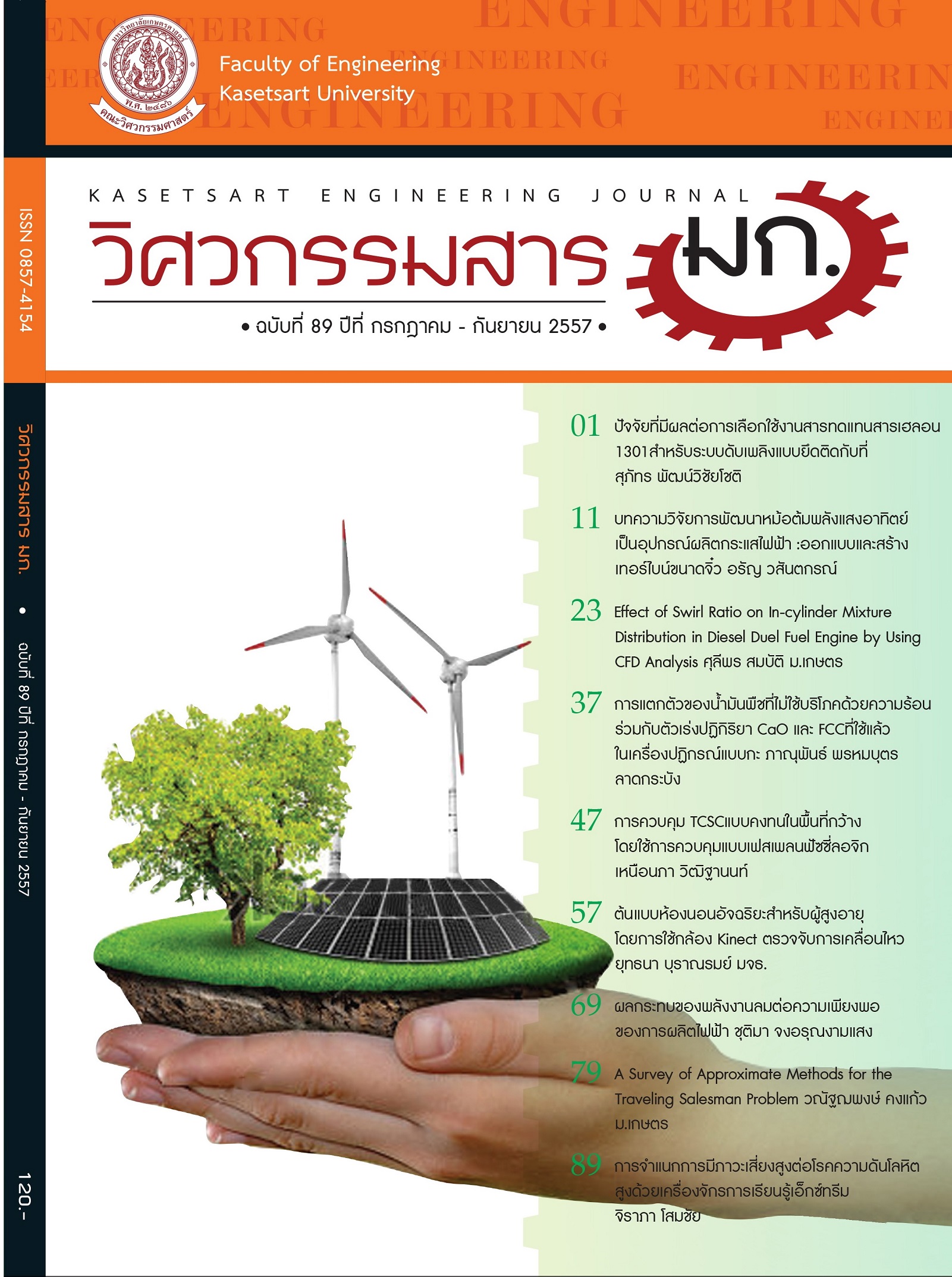การพัฒนาหม้อต้มพลังงานแสงอาทิตย์ เป็นอุปกรณ์ผลิตกระแสไฟฟ้า : ออกแบบและสร้างเทอร์ไบน์ขนาดจิ๋ว
Keywords:
หม้อต้มพลังแสงอาทิตย์, เซลล์แสงอาทิตย์แบบใช้หม้อต้มน้ำ, อุปกรณ์ผลิตกระแสไฟฟ้า, solar still, solar still cell, power generation cellAbstract
งานวิจัยนี้ทดลองพัฒนา Solar Still (ซึ่งแต่เดิมใช้กันเพื่อแยกน้ำออกจากเกลือหรือใช้ต้มน้ำร้อน) เป็นเซลล์ผลิตไฟฟ้า โดยหลักการของเซลล์ผลิตไฟฟ้านี้ คือ ใช้พลังงานแสงอาทิตย์เป็น input เพื่อไปต้มระเหยน้ำก้น Solar Still ให้กลายเป็นไอลอยขึ้นไปเกาะและควบแน่นบนหลังคากระจก ซึ่งเป็นการเพิ่มพลังงานศักย์แก่น้ำ เมื่อน้ำที่เกาะกระจกรวมตัวกันเป็นหยดใหญ่ขึ้นจะไหลไปตามผิวกระจกลงสู่รางรวบรวมน้ำในที่สุดน้ำที่ควบแน่นแล้วจะตกลงสู่เบื้องล่างของพื้น Solar Still (ช่วงนี้พลังงานศักย์ของน้ำเปลี่ยนเป็นพลังงานจลน์) ไปกระแทกใบพัดรูปกระบวยของระบบสกัดพลังงานจลน์จากน้ำจนเกิดการหมุน งานเพลาที่ได้จากการหมุนจานใบพัดรูปกระบวยจะถูกส่งกำลังไปขับไดนาโม เพื่อปั่นไฟฟ้าผ่านแกนต่อเชื่อม งานหลักของงานวิจัยนี้ ได้แก่ การออกแบบระบบสกัดงานเพลาจากพลังงานจลน์ของน้ำที่กำลังตกกระแทกให้เป็นไปอย่างมีประสิทธิภาพ โดยได้ทดลองออกแบบ และสร้างอุปกรณ์ดังกล่าวเป็นระบบจานโลหะติดใบพัดรูปกระบวยซึ่งประกอบด้วยใบพัดจำนวน 6 ใบ เสียบติดกับจาน และใบพลาสติกสำเร็จรูป (8 ใบพัด) ผลการทดลองระเหยและควบแน่นน้ำใน Solar still ต้นแบบที่สร้างพบว่า สามารถระเหย และควบแน่นน้ำได้เฉลี่ย 4.911 มิลลิลิตรต่อนาทีซึ่งมีค่าไม่มาก เพราะสังเกตได้ว่าน้ำตกเป็นหยดๆ แทนที่จะเป็นกระแสต่อเนื่อง ผลการทดสอบเดินเครื่องเซลล์ผลิตไฟฟ้าที่สร้างพบว่า ชุดใบพัดโลหะนั้นใหญ่และฝืดเกินที่แรงกระแทกจากหยดน้ำจะขับให้หมุนได้ มีเพียงชุดใบพัดพลาสติกเท่านั้นที่สามารถหมุนสกัดพลังงานจลน์จากหยดน้ำที่ตกลงมากระแทกได้ แต่ยังสามารถผลิตกระแสไฟฟ้าได้น้อยเพียงแค่ 0.3 μW เท่านั้น ลองวัดและคำนวณค่าประสิทธิภาพทางกลของระบบสกัดพลังงานจลน์ของน้ำในเซลล์ได้ค่าประมาณ 20% จึงเสนอให้ออกแบบระบบสกัดพลังงานจลน์จากน้ำที่ควบแน่นใน Solar Still รูปแบบใหม่ที่ให้แรงกระแทกที่แม่นยำ และต่อเนื่องมากกว่าแบบชุดจานใบพัดรูปกระบวย งานวิจัยนี้คำนวณค่าประสิทธิภาพการผลิตไฟฟ้าของเซลล์ผลิตไฟฟ้าที่พัฒนาขึ้นจากหม้อต้มพลังแสงอาทิตย์เซลล์นี้คร่าวๆ โดยนำพลังงานไฟฟ้าที่ผลิตขึ้นจากเซลล์หารด้วยความเข้มแสงอาทิตย์ที่ไม่ได้วัดค่า (หาเพียงข้อมูลความเข้มแสงอาทิตย์ในประเทศไทย แถวภาคตะวันตก) ได้ค่าเท่ากับ 1.23% หากมีการปรับปรุงชุดสกัดพลังงานจลน์จากกระแสน้ำให้มีประสิทธิ์ภาพสูงขึ้น ก็สามารถนำเซลล์ผลิตไฟฟ้าชนิดนี้ไปใช้ประโยชน์ได้อย่างดี โดยการสร้างภาชนะพลาสติก (หรือวัสดุอื่นๆ ที่หาง่ายและราคาไม่แพง) ครอบแหล่งน้ำขนาดเล็ก เช่น สระน้ำ แม่น้ำทะเล หรือ บนบก ก็ตาม ก็ผลิตกระแสไฟฟ้าได้ ซึ่งหากได้ voltage ต่ำ ก็สามารถต่อหลายๆ เซลล์เข้าด้วยกันแบบอนุกรมได้ และหากทำรางรับน้ำด้านนอกเซลล์ด้วย จะสามารถสกัดพลังงานจลน์จากน้ำได้ทั้งวันฝนตกและวันแดดออก เซลล์นี้สามารถช่วยแก้ปัญหาน้ำแล้งไปในตัวด้วย
The Development of Solar Still as a Power Generation Cell : Inventing a Small Turbine
The research develops a solar still, which is primitively used for water evaporation or desalination and making hot water, as a power generation cell. This solar power generation cell is working as a cycle that water inside a still is vaporized and raised to condense and cling on its glass roof. When those clinging water drops become larger enough, they will move down to an open channel located at the end of the glass roof. The collected water is then allowed to fall down and impact on a kinetic energy extracted equipment located near the still floor. This equipment is extracting water kinetic energy as shaft work. The water coming toward the still floor is then vaporized by sun light to the glass roof again. Here is the cycle of water vaporization-condensation. The turbine produced shaft power is transmitted to a dynamo for power generation. The research has designed the kinetic energy extracted equipment from water as a Pelton turbine system, both metal and plastic ones. The metal one includes a rotor disc on which 6 Pelton turbine blades are fixed. The finished plastic one includes 8 blades. The testing result of evaporation of water in the solar still shows a rather low vaporization-condensation rate. The averaged value of only 4.911 ml/min is obtained. The appearance of water falling down to impact the turbine blades is not a continuous stream but drops. Whereas the results of testing runs of the solar still power generation cell shows that impacting of water drops on the blades is not strong enough to rotate the metal disc, but it can rotate the plastic one. The plastic rotor can generate 0.3 μW of electrical power, which is very low. The result may be caused by inconsistency of frequency of dropping of water with moving of a blade toward the exact horizontal position. Transfer of kinetic energy from water to the rotor is thus inefficient. Mechanical efficiency of the turbine rotor + dynamo system is also determined. The obtained result is lower than 20%. The researcher then suggests a new design that may have more practical for extracting kinetic energy of water than the turbine rotor blade system. The research coarsely calculates the overall efficiency of this developed solar power generation cell by using solar intensity data in Thailand (around the Western Region) instead of measurement of the solar intensity by its own. The obtained figure is 1.23%.


